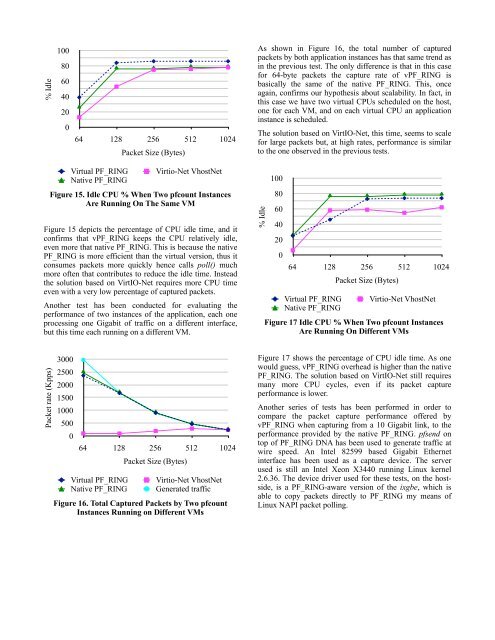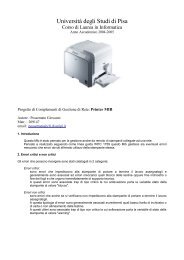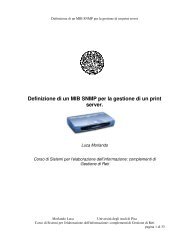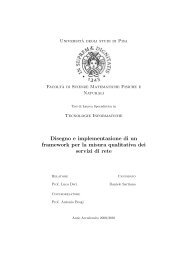vPF_RING: Towards Wire-Speed Network ... - Luca Deri - Ntop
vPF_RING: Towards Wire-Speed Network ... - Luca Deri - Ntop
vPF_RING: Towards Wire-Speed Network ... - Luca Deri - Ntop
You also want an ePaper? Increase the reach of your titles
YUMPU automatically turns print PDFs into web optimized ePapers that Google loves.
% Idle<br />
100<br />
80<br />
60<br />
40<br />
20<br />
0<br />
64 128 256 512 1024<br />
Packet Size (Bytes)<br />
Virtual PF_<strong>RING</strong> Virtio-Net VhostNet<br />
Native PF_<strong>RING</strong><br />
Figure 15. Idle CPU % When Two pfcount Instances<br />
Are Running On The Same VM<br />
Figure 15 depicts the percentage of CPU idle time, and it<br />
confirms that <strong>vPF</strong>_<strong>RING</strong> keeps the CPU relatively idle,<br />
even more that native PF_<strong>RING</strong>. This is because the native<br />
PF_<strong>RING</strong> is more efficient than the virtual version, thus it<br />
consumes packets more quickly hence calls poll() much<br />
more often that contributes to reduce the idle time. Instead<br />
the solution based on VirtIO-Net requires more CPU time<br />
even with a very low percentage of captured packets.<br />
Another test has been conducted for evaluating the<br />
performance of two instances of the application, each one<br />
processing one Gigabit of traffic on a different interface,<br />
but this time each running on a different VM.<br />
Packet rate (Kpps)<br />
3000<br />
2500<br />
2000<br />
1500<br />
1000<br />
500<br />
0<br />
64 128 256 512 1024<br />
Packet Size (Bytes)<br />
Virtual PF_<strong>RING</strong> Virtio-Net VhostNet<br />
Native PF_<strong>RING</strong> Generated traffic<br />
Figure 16. Total Captured Packets by Two pfcount<br />
Instances Running on Different VMs<br />
As shown in Figure 16, the total number of captured<br />
packets by both application instances has that same trend as<br />
in the previous test. The only difference is that in this case<br />
for 64-byte packets the capture rate of <strong>vPF</strong>_<strong>RING</strong> is<br />
basically the same of the native PF_<strong>RING</strong>. This, once<br />
again, confirms our hypothesis about scalability. In fact, in<br />
this case we have two virtual CPUs scheduled on the host,<br />
one for each VM, and on each virtual CPU an application<br />
instance is scheduled.<br />
The solution based on VirtIO-Net, this time, seems to scale<br />
for large packets but, at high rates, performance is similar<br />
to the one observed in the previous tests.<br />
% Idle<br />
100<br />
80<br />
60<br />
40<br />
20<br />
0<br />
64 128 256 512 1024<br />
Packet Size (Bytes)<br />
Virtual PF_<strong>RING</strong> Virtio-Net VhostNet<br />
Native PF_<strong>RING</strong><br />
Figure 17 Idle CPU % When Two pfcount Instances<br />
Are Running On Different VMs<br />
Figure 17 shows the percentage of CPU idle time. As one<br />
would guess, <strong>vPF</strong>_<strong>RING</strong> overhead is higher than the native<br />
PF_<strong>RING</strong>. The solution based on VirtIO-Net still requires<br />
many more CPU cycles, even if its packet capture<br />
performance is lower.<br />
Another series of tests has been performed in order to<br />
compare the packet capture performance offered by<br />
<strong>vPF</strong>_<strong>RING</strong> when capturing from a 10 Gigabit link, to the<br />
performance provided by the native PF_<strong>RING</strong>. pfsend on<br />
top of PF_<strong>RING</strong> DNA has been used to generate traffic at<br />
wire speed. An Intel 82599 based Gigabit Ethernet<br />
interface has been used as a capture device. The server<br />
used is still an Intel Xeon X3440 running Linux kernel<br />
2.6.36. The device driver used for these tests, on the hostside,<br />
is a PF_<strong>RING</strong>-aware version of the ixgbe, which is<br />
able to copy packets directly to PF_<strong>RING</strong> my means of<br />
Linux NAPI packet polling.






